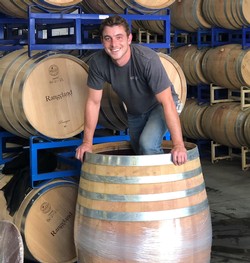Rangeland Terroir and Technique, Part 1: Harvest
We often speak of terroir and the ‘sense of place’ it brings to wine. Terroir is used to describe a particular region or site’s climate, soil, terrain, and tradition; such as the rusticity of a Northern Rhone syrah or the earthiness of a Burgundian pinot noir. Paso Robles wines are known for their fruit-forward power and structure, also the vibrancy that reflects the community that makes them. At Rangeland, we strive to craft wines that best represent this terroir of Paso Robles and our Adelaida Springs Ranch (ASR), but it’s a complex story.
Our ASR estate vineyard contains several soil types, slopes, and elevations that make it challenging to harvest. Our lowest elevation blocks of grapes are planted in droughty sandstone soils that ripen early--a rarity in Paso Robles. Sandstone brings broad-shouldered structure to the wines, as well as considerable depth and power. The highest elevation blocks contain limestone soils that are typical of Paso’s westside terroir and are later ripening. Limestone wines tend towards a precise and energetic structure. The middle elevation of the vineyard is planted on a mixture of these soils and includes gravelly, stressy outcrops of serpentine. This mélange of soils requires frequent fruit sampling (for sugar and acid levels) and tasting. To pick the grapes at optimum ripeness, harvesting often takes multiple hand-picked passes within a single block.
 Once the fruit is in the winery, we strive to preserve authentic terroir by practicing minimal intervention winemaking. You might say we shepherd rather than make the wine. First, the fruit is carefully sorted across a vibrating table to remove raisins, then mostly machine destemmed prior to fermentation. For Rhone varieties like syrah and grenache, we sometimes include stems in “whole cluster” lots to add aroma, tannic structure and complexity to the wine. Prior to fermentation, we stomp the grapes or lightly tread on them, breaking breakiing most of the grape skins to get some juices flowing for our cold soak. Although stomping may sound old-school and inefficient, leaving some of the berries unbroken or whole will encourage more aromatic complexity and refined textures. No need to overwork the grapes; we let them speak for themselves.
Once the fruit is in the winery, we strive to preserve authentic terroir by practicing minimal intervention winemaking. You might say we shepherd rather than make the wine. First, the fruit is carefully sorted across a vibrating table to remove raisins, then mostly machine destemmed prior to fermentation. For Rhone varieties like syrah and grenache, we sometimes include stems in “whole cluster” lots to add aroma, tannic structure and complexity to the wine. Prior to fermentation, we stomp the grapes or lightly tread on them, breaking breakiing most of the grape skins to get some juices flowing for our cold soak. Although stomping may sound old-school and inefficient, leaving some of the berries unbroken or whole will encourage more aromatic complexity and refined textures. No need to overwork the grapes; we let them speak for themselves.
Next, cold soaking is the traditional, pre-fermentation process of coaxing color and flavor from the grapes at cool temperatures, while not extracting harsh tannins. Cold soaking also allows the native yeast, present on the grape skins in the vineyard, to develop a healthy population that is strong enough to complete fermentation. Yeast is the biological workhorse that will convert grape sugars into alcohol. We shun commercial yeasts because the native type will enhance Rangeland’s unique sense of place.
Once fermentation has commenced, usually after a couple days, we turn to delicate pump-overs to promote fragrance and minerality rather than brash opulence. Pump-overs use the juice from the bottom of the fermenting vessel to soak the floating cap of grape skins and aerate the developing wine. Throughout fermentation, we monitor sugar levels and temperature while constantly tasting for the right amount of extraction and flavor before pressing.
When the fermentation is almost complete, we drain the wine off the skins and put it into barrels to encourage oak integration. This wine is called the “free run” and is typically the softest and most aromatic portion of the fermentation. We then take the grape skins and press off the remaining “press run” wine, which will provide us with more extraction and richness. The wines then settle in barrel while completing primary (yeast) and secondary (malolactic) fermentation. Later we’ll evaluate the expression of terroir and the vintage in the next best season of the year: blending.
Comments
Commenting has been turned off.Keep up to date on the latest wine releases, events, and promotions and get 10% off your next order.